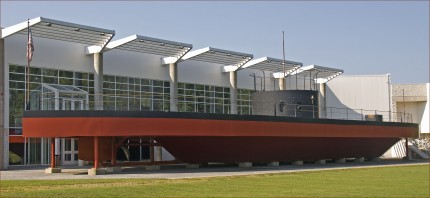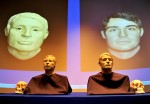 Secretary of the Navy Ray Mabus announced last week that the remains of two sailors recovered from the wreck of the USS Monitor, the Civil War ironclad warship that was on the Union side in the first battle of ironclads in history, will be buried at Arlington National Cemetery on March 8th, the 151st anniversary of the famous battle. Navy and U.S. National Oceanic and Atmospheric Administration (NOAA) representatives will pick up the remains from the military’s Joint POW/MIA Accounting Command (JPAC) in Hawaii and escort them to Virginia on March 7th. The next day’s burial ceremony with full military honors will take place at 4:00 PM. A horse-drawn caisson, a two-wheeled carriage used during the Civil War to carry artillery ammunition, will bear the caskets to their graves.
Secretary of the Navy Ray Mabus announced last week that the remains of two sailors recovered from the wreck of the USS Monitor, the Civil War ironclad warship that was on the Union side in the first battle of ironclads in history, will be buried at Arlington National Cemetery on March 8th, the 151st anniversary of the famous battle. Navy and U.S. National Oceanic and Atmospheric Administration (NOAA) representatives will pick up the remains from the military’s Joint POW/MIA Accounting Command (JPAC) in Hawaii and escort them to Virginia on March 7th. The next day’s burial ceremony with full military honors will take place at 4:00 PM. A horse-drawn caisson, a two-wheeled carriage used during the Civil War to carry artillery ammunition, will bear the caskets to their graves.
“These may very well be the last Navy personnel from the Civil War to be buried at Arlington,” said Mabus. “It’s important we honor these brave men and all they represent as we reflect upon the significant role Monitor and her crew had in setting the course for our modern Navy.”
The Monitor was the first ironclad warship made in the United States. It was a response to the news that the Confederacy had created a casemate ironclad over the hull of the former USS Merrimack, a steam-powered frigate that was docked at the Gosport Navy Yard in Virginia and had been half-assedly scuttled by Union forces as they evacuated after Virginia seceded. The Virginia and a flotilla of accompanying ships attempted to break the Union blockade by engaging the Union fleet at the Battle of Hampton Roads on March 8th, 1862. They were doing well, taking down several Union ships on the first day, but then they stopped on account of darkness. The second day the Monitor showed up and the two ironclads went head-to-head in an epic clash of iron titans.
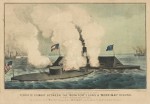 They fought each other for three hours. The Virginia had 14 gun ports and fixed guns positioned in each, much like traditional wooden ships only with iron cladding. The entire ship had to be turned in order to fire. The Monitor, on the other hand, had the advantage of a revolutionary rotating gun turret that could hold two massive Dahlgren artillery guns and 14 men. There were no breaks to stop the turning, though, and the close quarters, muzzle-loading and heat of the guns meant that they couldn’t just rotate the turret and fire at will. They were able to get off one shot every five to eight minutes. Most of the shots were fired as the turret turned. Since these ships weren’t exactly fast movers, those strafing shots still made contact.
They fought each other for three hours. The Virginia had 14 gun ports and fixed guns positioned in each, much like traditional wooden ships only with iron cladding. The entire ship had to be turned in order to fire. The Monitor, on the other hand, had the advantage of a revolutionary rotating gun turret that could hold two massive Dahlgren artillery guns and 14 men. There were no breaks to stop the turning, though, and the close quarters, muzzle-loading and heat of the guns meant that they couldn’t just rotate the turret and fire at will. They were able to get off one shot every five to eight minutes. Most of the shots were fired as the turret turned. Since these ships weren’t exactly fast movers, those strafing shots still made contact.
The final result was technically a draw. Both ships battered each other to a standstill and the Virginia withdrew. In strategic terms it was a win for the Union because they looked cool and because the blockade remained unbroken. The two ironclads met again on May 8th but did not engage, despite the Virginia‘s attempt to draw the Monitor out. Three days later, the Virginia was scuttled when Confederate forces withdrew from Norfolk.
On New Year’s Eve 1862, the Monitor sank in a storm off the coast of Cape Hatteras, North Carolina. It was being towed by the USS Rhode Island at the time, but its iron cladding and top-heavy turret made it particularly susceptible to rough ocean waters. Most of the 62 crewmen were rescued by the Rhode Island, but 16 went down with the ship.
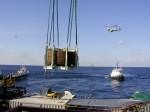 The wreck discovered on the Atlantic floor in August 1973. As attempts to raise the entire ship were deemed too likely to damage the wreck and too expensive, the site was named a National Marine Sanctuary and later a National Historic Landmark to protect it from treasure hunters and coastal traffic. Parts of it have been raised, however: the propeller in 1998, the steam engine in 2001 and on August 5, 2002, a team of Navy divers and NOAA experts, raised the 150-ton revolving gun turret.
The wreck discovered on the Atlantic floor in August 1973. As attempts to raise the entire ship were deemed too likely to damage the wreck and too expensive, the site was named a National Marine Sanctuary and later a National Historic Landmark to protect it from treasure hunters and coastal traffic. Parts of it have been raised, however: the propeller in 1998, the steam engine in 2001 and on August 5, 2002, a team of Navy divers and NOAA experts, raised the 150-ton revolving gun turret.
During the 41 day lead-up to the recovery of the turret, divers found the remains of two sailors, one on top of the other, who had been trapped inside the turret when the ship capsized and sank. The turret was found inverted with the crewmen buried under coal, debris and two Dahlgren guns 13.5 feet long. Despite 140 years spent under water and the rough circumstances of their demise, the sailors’ skeletons were almost complete.
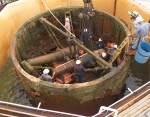 In the attempt to identify the crewmen, JPAC experts were able to extract DNA and discover a number of personal details. One was about 35 years of age and walked with a limp. He wore a gold ring and had a notch in his teeth indicating that he smoked a pipe. The other was about 21 years old and had broken his nose at some point. He wore mismatched shoes. JPAC was unable to pinpoint who the two men are, although the names of the 16 sailors who lost their lives aboard the Monitor are known and there are a number of pictures taken of the ship and crew. The DNA did not match any of the known descendants and family members of the Monitor crew.
In the attempt to identify the crewmen, JPAC experts were able to extract DNA and discover a number of personal details. One was about 35 years of age and walked with a limp. He wore a gold ring and had a notch in his teeth indicating that he smoked a pipe. The other was about 21 years old and had broken his nose at some point. He wore mismatched shoes. JPAC was unable to pinpoint who the two men are, although the names of the 16 sailors who lost their lives aboard the Monitor are known and there are a number of pictures taken of the ship and crew. The DNA did not match any of the known descendants and family members of the Monitor crew.
Last year, the 150th anniversary of the Battle of Hampton Roads, facial reconstructions made from the molds of the skulls were publicized in the hope that somebody might have some old family pictures that identified the men. It was a long shot, and unfortunately no information was discovered.
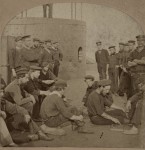 The three most likely candidates are Jacob Nicklis, Robert Williams and William Bryan. The reconstructed face of the older sailor does bear a resemblance to Williams, the 30-year-old Welsh-born first-class fireman of the Monitor, but they weren’t able to confirm the identification. In the picture at right left, Robert Williams is the strapping mustachioed fellow in the hat standing with his arms crossed on the right just behind the guys playing checkers.
The three most likely candidates are Jacob Nicklis, Robert Williams and William Bryan. The reconstructed face of the older sailor does bear a resemblance to Williams, the 30-year-old Welsh-born first-class fireman of the Monitor, but they weren’t able to confirm the identification. In the picture at right left, Robert Williams is the strapping mustachioed fellow in the hat standing with his arms crossed on the right just behind the guys playing checkers.
JPAC will continue to try to identify the sailors, but it’s been more than a decade since they were recovered from the ocean floor and the Navy believes it’s time to bury their remains.
Artifacts from the wreck site will continue to be recovered. The wreck, like many other iron ships, has become unstable and is in danger of imminent collapse. The NOAA wants to make every effort to save belongings of the crew and any parts of the ship they can over the next few decades before they decay. Past and future artifacts recovered from the wreck are conserved and displayed at the USS Monitor Center at the Mariners’ Museum in Newport News, Virginia, which also has a nifty full-sized replica of the Monitor outside the entrance which you can visit.
